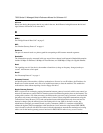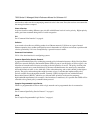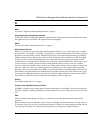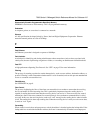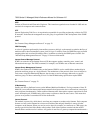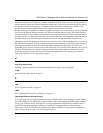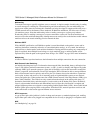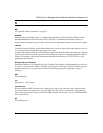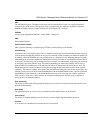
7000 Series L3 Managed Switch Reference Manual for Software v2.0
C-12 Glossary
IEEE
Institute of Electrical and Electronics Engineers. This American organization was founded in 1963 and sets
standards for computers and communications.
IETF
Internet Engineering Task Force. An organization responsible for providing engineering solutions for TCP/
IP networks. In the network management area, this group is responsible for the development of the SNMP
protocol.
IGMP
See “Internet Group Management Protocol” on page 12.
IGMP Snooping
A series of operations performed by intermediate systems to add logic to the network to optimize the flow of
multicast traffic; these intermediate systems (such as Layer 2 switches) listen for IGMP messages and build
mapping tables and associated forwarding filters, in addition to reducing the IGMP protocol traffic. See
“Internet Group Management Protocol” on page 12 for more information.
Internet Control Message Protocol
ICMP is an extension to the Internet Protocol (IP) that supports packets containing error, control, and
informational messages. The PING command, for example, uses ICMP to test an Internet connection.
Internet Group Management Protocol
IGMP is the standard for IP Multicasting on the Internet. IGMP is used to establish host memberships in
particular multicast groups on a single network. The mechanisms of the protocol allow a host to inform its
local router, using Host Membership Reports, that it wants to receive messages addressed to a specific
multicast group. All hosts conforming to Level 2 of the IP Multicasting specification require IGMP.
IP
See “Internet Protocol” on page 12.
IP Multicasting
Sending out data to distributed servers on the MBone (Multicast Backbone). For large amounts of data, IP
Multicast is more efficient than normal Internet transmissions because the server can broadcast a message to
many recipients simultaneously. Unlike traditional Internet traffic that requires separate connections for each
source-destination pair, IP Multicasting allows many recipients to share the same source. This means that
just one set of packets is transmitted for all the destinations.
Internet Protocol
The method or protocol by which data is sent from one computer to another on the Internet. Each computer
(known as a host) on the Internet has at least one IP address that uniquely identifies it among all other
computers on the Internet. When you send or receive data (for example, an e-mail note or a Web page), the
message gets divided into little chunks called packets. Each of these packets contains both the sender's
Internet address and the receiver's address. Any packet is sent first to a gateway computer that understands a



